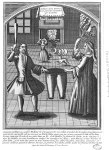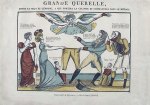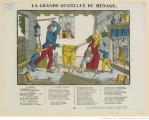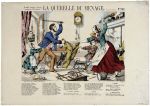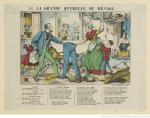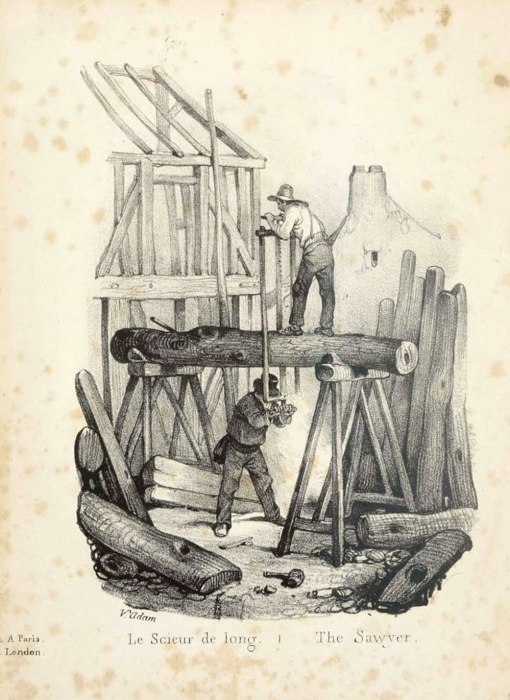
Continuing with the series on pit sawing; this is my translation of André Roubo’s description of the process from L’Art du menuisier (1769-82). Roubo offers us a unique view of pit sawing not yet covered in the other passages, that is, the pit sawing of seasoned wood into dimensions more suitable for joiners work, which differs from the process of converting green timber into salable lumber.
The long sawyers were used by the joiners as a kind of jobbing sub-contractor. It was not uncommon to have a shop owner buy thousands of feet of seasoned wood from a timber merchant and then pay the long sawyers to rip and resaw the wood to set dimensions, rather than pay skilled joiners to do the same, when the specialists would produce better results in the same time, and the joiners could be more profitably used elsewhere.
Like my previous translations, this is not polished work, though I have endeavored to make the passages easy to understand. Many of the sentences are left in their original format, and can be understood even though they read awkwardly, whereas others have been rewritten to better communicate their meaning in English. If you want a better translation, you will have to wait for the professionals.
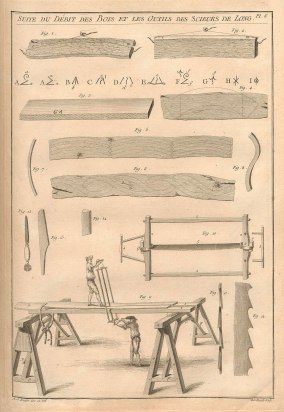
Roubo on Scieurs de Long:
When timber is to be sawed, we summon the long sawyers for ripping, they are always two together, & they furnish the type of saw for this job, the Joiners need only provide them with two trestles, & two pieces of wood named Coulottes: (I do not know if this term is very proper, yet it is the one used.)*
*In Roubo’s era, Coulottes were the silk knee breeches worn by upper class men. See below for an expanded explanation of this word.
The trestles should be made of strong wood, and be about four feet wide, about five to five and a half feet high; their head n, should be four thumbs thick by six thumbs wide; the legs o, three thumbs square with the crosspiece p at the bottom: at the midpoint on the head of this crosspiece is mounted two other pieces of wood q q, which abut against the top of the trestle about four thumbs from the mid point of each side; between these two uprights & a foot beneath the head of the trestle, there is assembled a crosspiece r, which serves to retain them.
On the midpoint of each trestle head, is a piece of wood s, approximately eighteen thumbs in length by two to three thumbs in thickness: on these two pieces are placed the ends of the coulottes t, which have a length of twelve to fifteen feet, about three thumbs in thickness, & five or six in width.
On the coulottes, & adjacent the trestle head, is a scrap board v, about two or three feet in length, which is bound to the coulottes by the manner of a rope x, which holds it flat and attaches it firmly against the trestles; this rope is tightened with a tourniqet* y, which is held in place behind the upright of the trestle. (Fig. 9). The long sawyer stands on this board when he is changing the wood being sawed, or else when they reach the end of the cut, he retreats onto it. There should be at least a thumb or a thumb and a half of space between the coulettes, in order to allow the passage of the saw.
*a wooden stick called a garrot, similar to that used to tension a bow saw. This technique of using a stick to tension ropes for workholding is known to have been used by the sawyers of ancient Egypt. Roubo is the only source I have read that covers this process. Of the many hundreds of pit sawing images that I have studied, only one clearly shows this garrot in use. What’s more, the image also shows a platform for the sawyer to stand on at the end of his cut.
The coulottes thus arranged, are used when ripping timber on the flat; but for resawing timber, they are turned and placed on their edge, and spaced in such a way that the wood to be resawed is gripped tightly between them. One end of these boards will be supported by the trestle, and they are attached with a rope and fastened as I said before, so that the board being resawed, the two coulottes, and the trestle are held together; the other end of the board is bourne by a piece of wood, which is made to the same height as the trestle, and which is moved accordingly as the saw advances.
The saw of the long sawyers, (Fig. 10) is composed of a chassis or frame twenty-six thumbs in width between the uprights, & four feet eight thumbs in height between the crosspieces or transoms; this width is the most common; but when the long sawyers have very large timber to divide, they provide saws whose frame is up to three feet in width, and even greater if necessary.
This frame is usually of fir, in order that it be lighter, and so that the uprights (n°. 1) shall not bend, they are usually two thumbs wide by one and a half thumbs in thickness, & are assembled with dowels in the transoms ( n°. 2 ), through which they pass; the transoms are three thumbs to three and a half thumbs wide at the ends, & four thumbs to four and a half thumbs in the middle; so that they are bulged to provide greater strength: they are two thumbs in thickness, & extend beyond the uprights by three thumbs on each side.
A small frame, called Renard*, is attached at right angles to the lower transom (n°. 3 ), which protrudes four thumbs from the transom, & is approximately twenty thumbs long: this renard is used to hold the saw from the bottom. Another frame is attached at the top transom of the saw, (n°. 4), named Chevrette*, which is spaced twelve to thirteen thumbs from the transom; the two uprights of this frame are angled inward, so that they do not emerge from within the transom, & these join with a small rounded crossbar, which is about fifteen thumbs long, & it exceeds them by three or four thumbs, so that the long sawyer can use it to raise and lower the saw.
*The top handle of the saw is called Chevrette (a young nanny-goat, kid) and the bottom handle is called Renard (fox). It is worth noting that the French top sawyer is called le chevrier (the goatherd) and the bottom sawyer is called le renard (the fox), or in some modern sources le renardier (the fox catcher).
The iron of the saw (n°. 5), is a blade of flat iron, about half a line in thickness & three thumbs wide at the ends, & four thumbs at the middle. To be good, it should be thicker along the edge of the teeth than behind them, & be free from flaws and inequalities; both ends are trapped by a kind of iron ring (n°. 6), which are called équiers, through which pass the transoms, and which protrude inside and outside the frame for receiving the saw, which is fastened by two iron pins, that make way for a wooden wedge ( n°. 7), that are put between the transom & the équiers, in order to stiffen the saw.
The teeth are made in the form of cremaillée* & with rounded corners: they are at a distance of one thumb from each other, and are three or four lines of depth; they do not file them square across, but on a bias, each tooth against the direction from one another. It should be observed that this bias does not appear in the hollow portion of the tooth, and that the bottom is at right angles or square with the saw. (Fig. 11 & 12.)
*A crémaillère is the adjustable hook used to hang pots over a chimney fire.
For circular works, the long sawyers make use of the saws called Raquettes, which are different from the others in that the plate or blade is at most a thumb or fifteen lines in width, in order to turn more easily.
The file which is used for filing or sharpening the long saw, is of an oval shape, about nine to ten thumbs in length, ten lines in width at the broadest point; this file has a wooden handle, at the end of which is located a piece of flat iron, of a circular shape approximately one thumb or fifteen lines in diameter, in which there are three different sized slots, & which are used to provide the set of the saw (Fig. 13).
Generally, to give set to a saw, means to spread the teeth beyond their thickness, one to the right and the next to the left, so that they pass easily through the wood. Saws are given more or less set according to their usage, as I shall say in its proper place; but in general the least amount of set which may be given is the best; one must also be careful that the set given to the saw never meets or exceeds half its thickness, because if that were so, the saw make too wide of a kerf, and consequently be too difficult to use. (Fig 12.).
The long sawyers do not make use of the d’entailles* for filing their saws; but rather they file with the saw frame lying against the ground, and the blade pressed against their knees. The two long sawyers, the one is down beneath the planks, & is always moving forward; and the other, on the contrary, is mounted upon the timber that is being sawed, and is always moving backwards, such that they are turned opposite one another:
*a type of simple saw vise made by running a groove along the length of a wooden beam. The blade is inserted and held with a wedge for filing. This is shown at H in Félibien’s plate 29, what Joseph Moxon refers to as a whetting block.
The filing technique described by Roubo is shown in this photo from a French postcard. Something similar is shown in this 1897 political cartoon, albeit with a bow saw.
When they have begun sawing their timber & after they have ripped a certain length, they will insert a wooden wedge that they call bon-dieu*, which is used to open the timber, & consequently to facilitate the passage of the saw: they drive this wedge in as they advance with another piece of thin wood. (Fig. 14 & 15).
*Literally good god, or for God’s sake !, for Pete’s sake !, for crying out loud ! etc
—End Translation
When Roubo names the planks, known in the industry as Coulottes, he feels the need to mention that the term is not very proper, yet it is the one used by the joiners and sawyers.
According to French technical dictionaries, the word was also defined as: thick planks used to support the top sawyer and his workpiece when sawing thin material or resawing: or a piece of wood used by plumbers in casting sheets of lead, or a wooden lifting-tool (of lead- workers).
As I have mentioned above, the word Coulottes referred to knee breeches in Roubo’s time, typically the fashionable breeches worn by the upper class.
In the French Revolution, the sans-culottes were the radical left-wing partisans of the lower classes; typically urban labourers, which dominated France. Though ill-clad and ill-equipped, they made up the bulk of the Revolutionary army during the early years of the French Revolutionary Wars. The appellation refers to the fashionable culottes (silk knee-breeches) of the moderate bourgeois revolutionaries, as distinguished from the working class sans-culottes, who traditionally wore pantalons (trousers).
I have noticed that the word was spelled three different ways during the 18th and 19th centuries, culotes, coulottes, and culottes. These breeches also appear in the political cartoons of the period depicting women’s struggle for the right to wear pants. For example, “La grande querelle du ménage” of 1712 (the great household quarrel), and the others that came after. If you would like to know what the word means today, well, the British call them knickers…
—Jeff Burks
